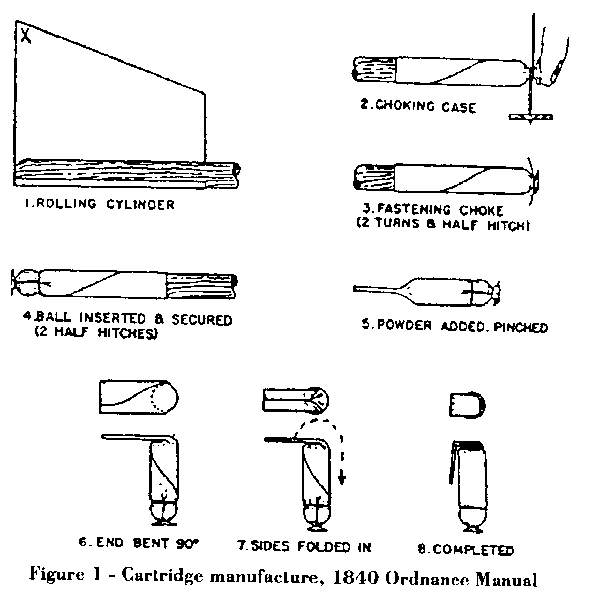Hi, I was just doing his three days ago with my 1777 An IX (same as a Charleville, only a Napoleonic era type).
I cast lots of .648 ball and lots of .330 buck. Used a cartridge block with drilled holes in it that are each about three inches deep, 11/16" wide.
I rolled cartridges, made of artists' newsprint paper. Cut the pieces of paper to be trapezoids that are 6 1/2" x 6" x 7" x 2 1/4".
Using a cartridge former (5/8" smoothed dowel), roll the tube with the ball in the end (see the diagram below). Tie off the end, good and tight, double knot it.
Then tie another knot just above the ball, but make sure the knot is narrower than 11/16". The knot and string have to fit down the barrel around the cartridge.
Push the cartridge with the former still fitted into the cartridge block.
Then remove the former and put the buck in. Two or three are enough. (I put in four, which made loading difficult.)
Then tie string above the buck, tighter so the string and knot don't exceed the width of the cartridge and bore.
The cartridge have to be tied off so that the buck doesn't roll down the barrel or stay in the barrel after firing. (It has happened to me....)
Fill the cartridge with 100 grains. I use 1f GOEX. It's a healthy kick, but, ten of those grains will be used up when you prime first. (That's how they did it back then....)
I fired it down at the range at ranges between 25 to 60 yards. It made a shredded mess of the 30x20 paper target.
The gun is pretty accurate when just firing ball, but with buck and ball, the accuracy suffered. The shots were all over the place, but mostly within a two foot radius of the center of the target. Not exactly MOA.....at least all of the shots hit the target, though.
Buck and ball was primarily used for close range volley firing, and must have been quite devastating at 40 yards. A well-trained infantry company, when given the order to fire, must have been like a tremendous shotgun going off.
The gun fouled very quickly, more so than when firing bare ball. The last few rounds were getting tough to ram home, so, after 20 shots, I called it a day.
When I do it again for this musket, I'll use .610 ball and lots more, but smaller, buck. That way the cartridge won't bulge out as much and make it hard to load.
The big ball and buck I used tended to make loading difficult very quickly. I'll save the remaining loads for a .775 call.1742 Long Land Pattern Musket.
Another type of buck and ball cartridge:

Diagram for rolling cartridges:

 Win a FREE Membership!
Win a FREE Membership!